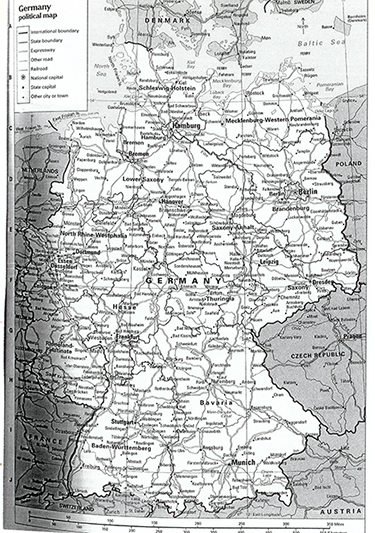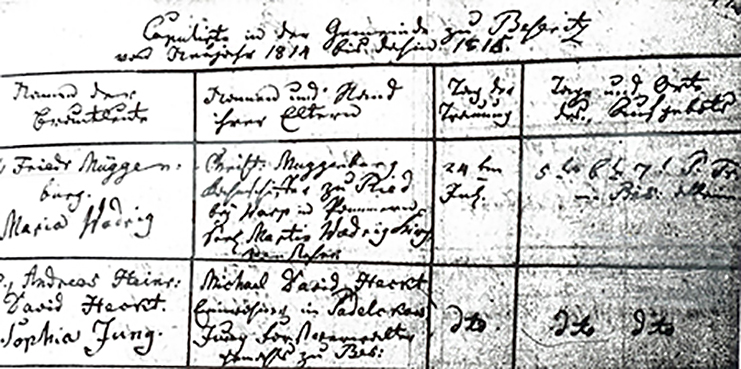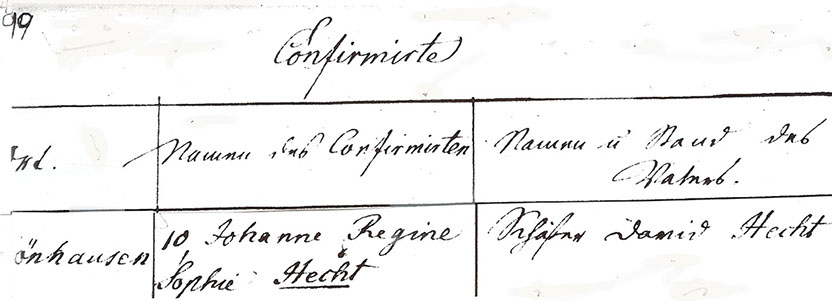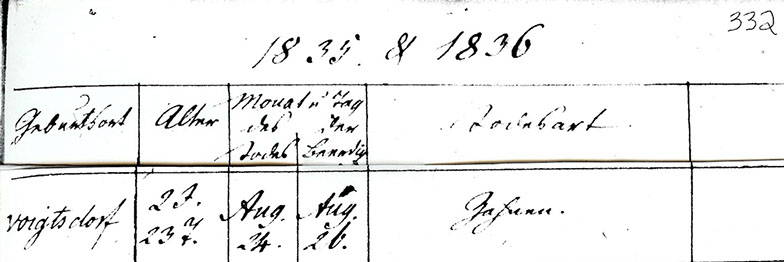

CHAPTER I
MECKLENBURG AND THE EARLIEST HECHTS
In order to understand the times in which our Hecht family lived, we need some historical background on Mecklenburg and particularly Mecklenburg-Strelitz where Henry was from.
Mecklenburg is a region of Germany that is in the northeast portion of modern day Germany, near the Baltic Sea. It is a farming region, generally flat with some low hills and numerous small lakes.
Map of Germany
In the 1500s, the Evangelical Church became the state church. During the 1600s, a proclamation was made requiring every parish in Mecklenburg to maintain Kirchenbuchers (registers of births and marriages). Mecklenburg also had a few Roman Catholic and Evangelical Reformed churches that also kept church records. Marriage registers sometimes gave the three dates on which the marriage intentions were announced. These announcements, called banns, gave opportunity for anyone to come forward who knew any reasons why the couple should not be married.
In 1701, Mecklenburg was divided into two duchies, Mecklenburg-Schwerin and Mecklenburg-Strelitz. In these early years, most of the land was in large estates held by powerful landowners who controlled the economy and ruled their estate with absolute authority. Peasants had few rights and found themselves at the mercy of the landowners. In 1820, the peasants were freed from their obligations to land owners. However, this worsened their condition because the landowners did not need to support them, which left them in greater poverty. By 1829, over 83,000 persons were living in Mecklenburg-Strelitz.
Prior to 1874 there was no single country called Germany. There were German people and a German language but they lived in different kingdoms, principalities, duchies, etc., with their own rulers and laws. In 1871 at the end of the Franco-Prussia war, Mecklenburg became part of the German Empire. Civil authorities in Mecklenburg began registering births, marriages, and deaths in 1876. The records I have used came from the church records rather than civil records.
In 1918 the Grand Dukes of Mecklenburg-Schwerin and Mecklenburg-Strelitz were deposed and by 1934, the two grand-duchies were united to create the State of Mecklenburg.
In 1945, the British and Soviet troops captured Mecklenburg and placed it under Soviet occupation until 1949 when Mecklenburg came under the jurisdiction of the German Democratic Republic known as East Germany. In 1990, East and West Germany were reunited and the region of Mecklenburg became part of the new State of Mecklenburg-Vorpommern.
The towns of Badresch, Schönhausen, Beseritz, Dahlen, and Brohm, Mecklenburg, are of interest to this family. Records for Henry Hecht and his ancestors mention all of these towns. The towns are all near the larger city of Neubrandenburg, which can be located on a modern map of Germany. Schönhausen is east of Neubrandenburg; Beseritz, Sadelkow, and Brohm are northeast or east of Neubrandenburg; and Dahlen is north of Neubrandenburg. They all appear to be within a few miles of each other.
EARLIEST HECHT FAMILIES
I have written to German church archives and researched church records on microfilm and have found some limited information on the Hechts who stayed in Germany. The following shows two generations—Henry Hecht’s parents and grandparents. A sample of the German alphabet in old German scriptA and several samples of baptism, marriage, and death records are included.
To leave one’s home country and travel to a foreign land without knowing what to expect, how to communicate in the new language, whether life would be better or not, to give up one’s family—oh what difficult decisions they made. It is hard to understand how they had the courage to emigrate and immigrate.
During the period of 1850 to 1890, Mecklenburg, with a population of only 420,000 people, had 148,000 emigrate, the majority to the United States. Most of them were peasants, struggling in poverty, looking for a better life. Many reasons contributed to leaving their homeland such as poverty, poor crop harvest, potato famine, small amounts of available land, compulsory military service, and the inability to get permission to marry. In order to marry, proof of assets was required such as a house, land, or tools. Often young people had to wait until late in life to marry and as a result, illegitimate births were common.
Most Mecklenburg emigrants left through the port of Hamburg with their names listed in departure records. Southern and western Germans tended to emigrate through the ports of Bremen or Le Havre, France. Northern and eastern Germans tended to leave through Hamburg. The lists usually show the emigrant’s name, age, occupation, and destination. In addition, the Hamburg passenger lists give the last residence. People wanting to leave Mecklenburg were required to request permission from the government. The majority of families and single men filed petitions for permission to emigrate, although some left illegally. Of those who immigrated to the United States, about ninety per cent of more than 23,000,000 emigrants arrived at New York City and five million arrived at other ports. Also, immigration arrival lists exist in the United States ports of arrival.
A German Script alphabet chart is available in the Appendix.


Map of Mecklenburg, Germany
THE VOYAGE
In the early year 1840s and 1850s, travel from Europe to the United States was usually on a sailing ship. Although many ships had first class and steerage, most passengers could not afford first class accommodations and conditions in steerage were often poor. The lowest deck stowed merchandise going to the new land. The next deck was for steerage passengers and space was very limited. Often there was not any more room than needed to lie down to sleep. Sanitation was terrible as buckets were used for seasickness and toilets. Bathing was impossible and food sometimes ran out before the end of the voyage. On sailing ships, the trip often took forty to fifty-five days. Steam ships became more common in the 1860s and conditions improved. The ship was still cramped, but hygiene was better and the steamers could make the trip in ten or more days.
1. MICHEL DAVID1 HECHT
Michel David and Greta Maria Funk married on 30 April 1784 in Sadelkow, Ruhlow, Mecklenburg.1
Known child of Michel David1 and Greta Marie (Funk) Hecht:
+ 2 i. ANDREAS HEINRICH DAVID2 HECHT, born 14 March 1795.
2. ANDREAS HEINRICH DAVID2 HECHT (Michel1)
David was born 14 March 1795 and baptized on 22 March of the same year.2 He married Sophie Jung or Junk on 24 July 1814 in Dahlen-Beseritz, Mecklenburg.3
This record is from the “Copulation” church register for 1814. The first column shows the name of the bride and groom, second column shows Eltern (parents), the third column is the date, and the fourth column are the dates for reading the marriage banns.
It was common to give three or four first and middle names to children and often the person used the last one as their first name. For example, Andreas Heinrich David Hecht was referred to as David in subsequent church records.

Church Register 1814
According to church records, David was a shepherd in 1830 in Schönhausen, and a shepherd in 1845 in Brohm. Another researcher told me that Michel David Heckt [sic], from Sadelkow, married Sophia Jung and her father was deceased but had been a Forstverwalter (forest manager).
Sophie’s name varies in spelling on her children’s baptismal records. Her given name was listed as Sophie and Sophia. Since two daughters were named Sophie, we will assume that was the correct spelling. Her surname was listed as Jung and Junk. The correct spelling is unknown.
David and Sophie had eight children. Henry migrated to America. Further information on the other Hecht children is not available.
Known children of David2 and Sophie (Jung) Hecht:
3 i. ELISABETH JOHANNA REGINA3 HECHT, born 8 March 1815 in Beseritz/Dahlen, Mecklenburg, baptized on 19 March 1815, and confirmed in 1829 in Badresch Parish in Schönhausen.4
4 ii. JOHANNE REGINE SOPHIE3 HECHT, born ca 1820, Badresch, Mecklenburg, confirmed 1835 in Schönhausen.5 This confirmation record shows Johanne Regine Sophie Hecht was confirmed in 1835, in the town of Schonhausen, was born in Badresch, was age 15, and her father was David Hecht.


Johanne Regine Sophie Hecht confirmation record, 1835
5 iii. CARL FRIEDRICH3 HECHT, born 22 July 1822 in Badresch, Mecklenburg, and baptized 4 August 1822.6
6 iv. JOHANN CARL DAVID3 HECHT, born 6 May 1824 in Schönhausen, Badresch, Mecklenburg, and baptized 23 May 1824 in Badresch.7
7 v. HEINRICH LUDWIG FRIEDRICH3 HECHT, born 7 August 1826 in Schönhausen, Badresch, Mecklenburg, and baptized 20 August 1826.8
8 vi. EMILIE FRIEDERIKE SOPHIE3 HECHT, born 31 July 1828 in Badresch and baptized on 17 August 1828. Sophie’s maiden name was listed as Funcken from the town records of Dahlen.9
+ 9 vii. JOHANN FRIEDRICH WILHELM HEINRICH “HENRY”3 HECHT, born 19 September 1830
10 viii. HENRIETTE LOUISE CAROLINE3 HECHT, born 31 July 1833 in Schönhausen, and baptized 11 August 1833. She died 24 August 1835 at age two years twenty-three days and was buried two days later in Schönhausen.11


Henriette Louise Caroline Hecht, death record, 1835
— NOTES —
The following abbreviations are used in these notes.
Family History Library – FHL
1 Email dated 18 August 2004 to the author from Evangelisch-Lutherische, Landeskirche, Mecklenburg, Münzstr 8–10, D–19055, Schwerin, Germany. [The information is from the Mecklenburg parish register, National Church Archives, Schwerin, Germany.]
2 David Hecht birth and baptismal record, Badresch Parish, 1823–1875 Schönhausen, Voigtsdoft, and Matzdorf, baptism, confirmation, and death records, National Church Archives, Schwerin, Germany; FHL no. 69709.
3 Hecht–Jung marriage, Mecklenburg-Strelitz, Dahlen Church records, Taufen, Heiraten, Tote, Konf. 1799–1934, marriages Beseritz 1814, page 47; FHL no. 69721.
4 Elisabeth Johanna Regina Hecht baptismal record, Badresch Parish, Mecklenburg-Strelitz, 1823–1875, Schönhausen, Voigtsdorf, Matzdorf, volume 4: 485–486; FHL no. 69709. [David Hecht was listed as her father.]
5 Johanne Regine Sophie Hecht confirmation record, volume 4: 499–500; FHL no. 69709. [Sophie, daughter of David Hecht, was confirmed at age fifteen.]
6 Carl Friedrich Hecht birth and baptismal record; e-mail dated 18 August 2004 to the author from Evangelisch-Lutherische, Landeskirche, Mecklenburg, Münzstr 8–10, D–19055, Schwerin, Germany. [The information is from the Mecklenburg parish register, National Church Archives, Schwerin, Germany.]
7 Johann Carl David Hecht, birth and baptismal record, volume 4: 31–32; FHL no. 69709.
8 Heinrich Ludwig Friedrich Hecht birth and baptismal record, volume 4: 53–54; FHL no. 69709. [Sophie’s surname was spelled Funck on this record.]
9 Emilie Friedericke Sophie Hecht baptismal record, volume 4: 69–70; FHL no. 69709.
10 Henriette Louise Caroline Hecht, baptismal record, volume 4: 105–106; FHL no. 69709.
11 Henriette Louise Caroline Hecht, death record, volume 4: 331–332; FHL no. 69709.
© Marian McCreary 2015